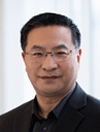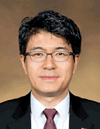Keynote Session
Plenary Session I: Opening and Keynote Speeches
10:30-12:00, October 28 (Wednesday), 2015
| Time | Title | Invited Speakers |
|---|---|---|
| 10:30-12:00 | Keynote Speech 1: “Future Vision and Key Enabling Technologies for IoT” | Dr. Jong-Deok (JD) Choi Executive Vice President Samsung Electronics |
| Keynote Speech 2: “The Future of Mobile Computing and Communications toward the 5G/6G Era” | Dr. Geng Wu CTO and Intel Fellow Intel Corporation |
|
| Opening Address | Dr. Jong-Seon No President of KICS |
|
| Welcome Address | Dr. Yanghee Choi Minister of MSIP |
Keynote Speech 1:
“Future Vision and Key Enabling Technologies for IoT”
Dr. Jong-Deok (JD) Choi, Executive Vice President, Samsung Electronics
Abstract:
Today, Internet of Things (IoT) is a reality of the world-wide IT industry and is being accelerated rapidly. Analysts predict that more than several hundred billion connected ‘Things’ will be in use globally by the end of 2020. The IoT is on track to become the primary enabling technology for digital business reaching many different products and services. The three driving components for the IoT technology are devices, connectivity among them, and services on top of these interconnected devices. The device technology covers from traditional devices like desktop and laptop computers, handheld mobile devices to a diverse range of sensors and everyday small things. The connectivity technology enables communication among various devices and allows them to interact with the external environment. An IoT device senses its surrounding environment, analyzes the gathered data, then carry out context-sensitive actions for offering the right service. Samsung has been leading the cutting-edge research in these three areas (devices, connectivity and services) to create solutions that effectively respond to challenging requirements of the IoT market. These solutions will be continuously improved and new solutions will be developed by collaborative partnerships between Samsung and other major IoT players. Through the industry collaboration, Samsung will be able to provide better user experience and smarter environment where different devices from various industries are seamlessly connected. Samsung is committed to deliver new value to everyone's daily life on its grand vision for IoT. By 2020, the entire Samsung devices will be IoT-enabled. However, it will take more than one organization or industry leader to unlock the full potential of IoT. Collaboration crossing different IT industries is a must in order to reach its fullest potential.
Biography:
 |
Dr. Jong-Deok (JD) Choi serves as Executive Vice President of Samsung Electronics Co., Ltd. He currently manages Samsung Software R&D Center (SWC). His primary responsibility includes leading all development aspects of the Tizen Open Source Platform for Samsung devices ranging from smart phones, tablets, and IVI (In-Vehicle Infotainment). As a founder and the President of Open Interconnect Consortium (OIC) - global industry group of more than 90 member companies including CISCO, GE, Intel, IBM, HP, Dr. Choi drives global industry consolidation of the Internet of Things (IoT) around common interoperable standards and open source solutions (http://openinterconnect.org/). Prior to Samsung, Dr. Choi has held a variety of research and management positions at IBM T. J. Watson Research Center. |
With more than 20 years of research in the areas of compiler and system
debugging technologies, he has numerous publications and patents on
interprocedural dataflow analysis, pointer analysis, escape analysis of threads,
extent analysis of Java, execution replay, and datarace detection.
Keynote Speech 2:
“The Future of Mobile Computing and Communications toward the 5G/6G Era”
Dr. Geng Wu, CTO of Wireless Standards, Intel Fellow, Intel Corporation
Abstract:
The evolution of high speed wireless and Moore’s Law are on an intersect course. Together, they are enabling the infusion of computing and connectivity into virtually anything, giving rise to the Internet of Things. Intel’s pioneering efforts in NFV, virtualized RAN, and small cells enabled next-generation core and access networks. Intel’s design and manufacturing technologies enabled mobile devices to continue to evolve in size, form, function and computing capability to give us many new categories of devices, such as wearables, connected automobiles, connected home appliances, smart cities and other applications. Today wireless industry is at a turning point. On wireless communication technologies, further improving spectral efficiency at individual radio link level is becoming increasingly challenging. We need to find new ways to build our future networks and devices to meet our ever increasing capacity demands. On services and applications, as smartphone penetration accelerating globally and starting to saturate in many developed markets, we need to develop new technologies that make things smarter, our daily work more efficient and our living environment intelligent. On user experience, we need to create a technology foundation that enables future generations of applications and services for the coming decades that are likely beyond what we could imagine today. To achieve these goals, 5G and future generations of networks and devices are about the combination of computing and communications, and about end-to-end solutions. This is a paradigm shift from previous generations where technology development focused primarily on communications. In this new 5G era, Intel is uniquely positioned in the world with its breadth and depth of design expertise, engineering capability and scale in both computing and communications. This presentation will discuss this paradigm shift and what it means to the industry, key challenges and opportunities, and future research directions. It will highlight Intel’s technology vision for future mobile computing and communications. This is a mission of unprecedented global scale. It requires many industries to work together and innovate, governments to change regulations, and academic research community to come up with new technology breakthroughs. Intel has a long history of partnership with Korean high-tech industries and research communities, from network virtualization, cloud RAN to air interface technologies. Recent SKT-Intel joint demonstration of anchor-booster network architecture for mmWave communication at MWC 2015 offered an early taste of what 5G performance could offer to end users. And there are more to come.
Biography:
The evolution of high speed wireless and Moore’s Law are on an intersect course. Together, they are enabling the infusion of computing and connectivity into virtually anything, giving rise to the Internet of Things. Intel’s pioneering efforts in NFV, virtualized RAN, and small cells enabled next-generation core and access networks. Intel’s design and manufacturing technologies enabled mobile devices to continue to evolve in size, form, function and computing capability to give us many new categories of devices, such as wearables, connected automobiles, connected home appliances, smart cities and other applications. Today wireless industry is at a turning point. On wireless communication technologies, further improving spectral efficiency at individual radio link level is becoming increasingly challenging. We need to find new ways to build our future networks and devices to meet our ever increasing capacity demands. On services and applications, as smartphone penetration accelerating globally and starting to saturate in many developed markets, we need to develop new technologies that make things smarter, our daily work more efficient and our living environment intelligent. On user experience, we need to create a technology foundation that enables future generations of applications and services for the coming decades that are likely beyond what we could imagine today. To achieve these goals, 5G and future generations of networks and devices are about the combination of computing and communications, and about end-to-end solutions. This is a paradigm shift from previous generations where technology development focused primarily on communications. In this new 5G era, Intel is uniquely positioned in the world with its breadth and depth of design expertise, engineering capability and scale in both computing and communications. This presentation will discuss this paradigm shift and what it means to the industry, key challenges and opportunities, and future research directions. It will highlight Intel’s technology vision for future mobile computing and communications. This is a mission of unprecedented global scale. It requires many industries to work together and innovate, governments to change regulations, and academic research community to come up with new technology breakthroughs. Intel has a long history of partnership with Korean high-tech industries and research communities, from network virtualization, cloud RAN to air interface technologies. Recent SKT-Intel joint demonstration of anchor-booster network architecture for mmWave communication at MWC 2015 offered an early taste of what 5G performance could offer to end users. And there are more to come.
Biography:
 |
Dr. Geng Wu is an Intel Fellow and CTO of Wireless Standards, Intel Corporation. He currently leads Intel’s global 5G wireless technology development and ecosystem standards collaborations. Dr. Wu has more than 20 years of research and development experience in the wireless industry. He has contributed extensively to global 2G CDMA, 3G 1xRTT/UMTS/HSPA and 4G WiMAX/LTE radio interface and network architecture design and development. His current research interests include future mobile computing and communication platforms, network function and mobile device computing virtulization, radio channel modeling, next-generation air interface technologies, and user experience for mobile services and applications. Before joining Intel, Dr. Wu served as Director of wireless architecture and standards at |
Nortel Networks, where he was responsible for system performance, standards
research, and technology development in 3GPP2, 3GPP, IEEE and WiMAX. Dr. Wu
received his Ph.D. in telecommunications from Université Laval in Québec,
Canada; and his bachelor's degree in Electrical Engineering from Tianjin
University in Tianjin, China. He has been issued more than 30 U.S. patents, and
authored or co-authored 40 research publications in the field of mobile wireless
communications and networking.
Plenary Session II: Keynote Speeches
11:00-12:00, October 29 (Thursday), 2015
Time
Title
Invited Speakers
11:00-12:00
Keynote Speech 3: “SK Telecom’s Mobile Broadband
Innovation for the Value-Creating Network”
Mr. Jin-Hyo Park
Senior Vice President
Head of Network
Technology
R&D Center, SK Telecom
Keynote Speech 4: “Smart Media in the Wireless
Environment”
Mr. Colin Nurse
Chief Technology Officer
Microsoft
| Time | Title | Invited Speakers |
|---|---|---|
| 11:00-12:00 | Keynote Speech 3: “SK Telecom’s Mobile Broadband Innovation for the Value-Creating Network” | Mr. Jin-Hyo Park Senior Vice President Head of Network Technology R&D Center, SK Telecom |
| Keynote Speech 4: “Smart Media in the Wireless Environment” | Mr. Colin Nurse Chief Technology Officer Microsoft |
Keynote Speech 3:
“SK Telecom’s Mobile Broadband Innovation for the Value-Creating Network”
Mr. Jin-Hyo Park, Senior Vice President, Head of Network Technology R&D
Center, SK Telecom
Abstract:
As the world’s most innovative mobile service provider, SK Telecom is creating the future of mobile and delivering cutting-edge, converged wireless technologies for the global market. The company is a pioneer in the mobile industry, having been the first to launch and commercialize CDMA, 3G CDMA, 3.5G HSDPA among other mobile services, and is now leading the way in 4G and beyond. This presentation will cover what SK Telecom has done so far to bring a true mobile broadband experience into our life. In addition to CDMA, WCDMA, HSDPA, and HSPA+, SK Telecom launched the nation’s first LTE service in July 2011. SK Telecom also became the world’s first mobile carrier to commercialize 150Mbps LTE-Advanced in June 2013 and 225Mbps LTE-Advanced in June 2014 through Carrier Aggregation (CA). In line with its efforts to swiftly move towards the next-generation mobile network system including 5G, it successfully commercialized 300Mbps tri-band LTE-A CA. SK Telecom will also present the view and strategy on the network evolution to prepare more accelerated mobile broadband in the future. The future network needs to accommodate more and more data traffic efficiently and enable new valued services. To achieve this goal, SK Telecom proposes four directions in network evolution, “Simple”, “Unified”, “Responsive”, and “Enhanced”. Based on the four directions, the future network can take many advanced technologies, e.g., virtualization, analytics, ultra-dense network, etc., and it should be “Value-Creating Network”. In line with network evolution, SK Telecom is seeking new growth engines through three innovative platforms namely Lifestyle Enhancement Platform, Advanced Media Platform and IoT Service Platform. Finally, this presentation will discuss the 5G network and services. SK Telecom holistically defines 5G as end-to-end network architectures and services, promising the greater values in terms of (1) user experience, (2) connectivity, (3) reliability, (4) efficiency, and (5) intelligence. Based on the ultra-fast speed, massive connectivity, and platformized valued network, many new services will be coming up (e.g., immersive virtual experience, massive/mission-critical IoT, etc.).
Biography:
As the world’s most innovative mobile service provider, SK Telecom is creating the future of mobile and delivering cutting-edge, converged wireless technologies for the global market. The company is a pioneer in the mobile industry, having been the first to launch and commercialize CDMA, 3G CDMA, 3.5G HSDPA among other mobile services, and is now leading the way in 4G and beyond. This presentation will cover what SK Telecom has done so far to bring a true mobile broadband experience into our life. In addition to CDMA, WCDMA, HSDPA, and HSPA+, SK Telecom launched the nation’s first LTE service in July 2011. SK Telecom also became the world’s first mobile carrier to commercialize 150Mbps LTE-Advanced in June 2013 and 225Mbps LTE-Advanced in June 2014 through Carrier Aggregation (CA). In line with its efforts to swiftly move towards the next-generation mobile network system including 5G, it successfully commercialized 300Mbps tri-band LTE-A CA. SK Telecom will also present the view and strategy on the network evolution to prepare more accelerated mobile broadband in the future. The future network needs to accommodate more and more data traffic efficiently and enable new valued services. To achieve this goal, SK Telecom proposes four directions in network evolution, “Simple”, “Unified”, “Responsive”, and “Enhanced”. Based on the four directions, the future network can take many advanced technologies, e.g., virtualization, analytics, ultra-dense network, etc., and it should be “Value-Creating Network”. In line with network evolution, SK Telecom is seeking new growth engines through three innovative platforms namely Lifestyle Enhancement Platform, Advanced Media Platform and IoT Service Platform. Finally, this presentation will discuss the 5G network and services. SK Telecom holistically defines 5G as end-to-end network architectures and services, promising the greater values in terms of (1) user experience, (2) connectivity, (3) reliability, (4) efficiency, and (5) intelligence. Based on the ultra-fast speed, massive connectivity, and platformized valued network, many new services will be coming up (e.g., immersive virtual experience, massive/mission-critical IoT, etc.).
Biography:
 |
Mr. Jin-Hyo Park is Senior Vice President and Head of Network Technology R&D Center of SK Telecom. He is currently responsible for the development of wireless technologies at SK Telecom. He joined SK Telecom in 1997, and worked for the IRIDIUM project and 3GPP standardization. From 2004, he has not only contributed to the commercialization of WCDMA and HSDPA/HSUPA, but also took a responsibility for the R&D strategy of SK Telecom. Since 2009, he has successfully led the Korean first LTE launch, the world-first multi-carrier deployment, the world-first nation-wide HD Voice (VoLTE) commercialization, and the world-first LTE-A (Carrier Aggregation) commercialization, and he is now directing LTE evolution and beyond LTE-A of SK Telecom. His current interest mainly focuses on advanced communication systems including LTE-A, B4G(5G), NFV/SDN, and Network Analytics. He received a Bachelor’s degree in Mathematics and a Master’s degree in Information & Communication Engineering from Korea University. |
CDMA service in 1996 and the WCDMA/HSDPA service in 2006, respectively. He is
credited to build SK telecom’s LTE commercialization strategy and roadmap when
the LTE was introduced firstly in 2011. In 2013, he contributed to
commercializing real-time IPTV UHD service and expanding the premium broadband
business while serving as the Head of Network Division of SK broadband. Since
2014, he has led the Network Division of SK Telecom while making the successful
progress in LTE/LTE-A services, such as 3-band LTE-A (300Mbps).
Keynote Speech 4:
“Smart Media in the Wireless Environment”
Mr. Colin Nurse, Chief Technology Officer, Microsoft
Abstract:
The retail Industry is struggling to compete with the online retailers. It is a common place scene now to see consumers look at instore products to see touch and feel the products and then look online for pricing. Ensuring the in-person shopping experience is in line with what modern consumers expect to see, the traditional stores are responding back with smart media, wireless technologies and consumer history directing consumers to products that the consumer wants at a price they can afford. Improvements in the smart media and Wireless are providing the platform for the modern retail experience outside and inside the traditional store.
Biography:
The retail Industry is struggling to compete with the online retailers. It is a common place scene now to see consumers look at instore products to see touch and feel the products and then look online for pricing. Ensuring the in-person shopping experience is in line with what modern consumers expect to see, the traditional stores are responding back with smart media, wireless technologies and consumer history directing consumers to products that the consumer wants at a price they can afford. Improvements in the smart media and Wireless are providing the platform for the modern retail experience outside and inside the traditional store.
Biography:
 |
Mr. Colin Nurse’s role as Chief Technology Officer for Microsoft’s Global & Multi National Accounts organization is to engage with Microsoft’s very best enterprise customers and their use of new products and services to address their current and future business needs. The objective of the GAO/MNC CTO role is to provide “trusted advisor” support for the major IT strategies and customer business transformations by utilizing technology and modern IT to address the customer’s key business objectives. Colin has IT business, architecture and global IT service delivery skills that focus on unified communications, IT consolidation and the provision of new hosted services. Typically, the non-technical issues are the hardest |
to work through. From personal experiences, Colin has led many successful
projects to support how to help solve blockers and successful transitions that
provide benefits to the customer’s business. Colin is located at Microsoft’s
headquarters in Redmond, WA which enables him to provide two-way communication
exchange between customers, industry experts, Microsoft field teams, and
engineering groups based in Redmond. Colin is a business focused IT professional
with a track record of delivering and executing enterprise IT strategies that
provide major business benefits through significant cost reduction, service
enhancement and provision of new IT services through process re-engineering and
adoption of new technologies. He brings with him years of IT experience with
in-depth business knowledge of the Public Sector, Justice and Public Safety,
DOD, Pharmaceutical, Manufacturing, SaaS and Higher Educational industries.
Plenary Session III: Keynote Speeche
10:30-11:00, October 30 (Friday), 2015
Time
Title
Invited Speakers
10:30-11:00
Keynote Speech 5: “Intelligent and Connected:
Moving forward in IoT”
Dr. Krisztián Flautner
General Manager
Internet of Things
(IoT) Business
ARM
| Time | Title | Invited Speakers |
|---|---|---|
| 10:30-11:00 | Keynote Speech 5: “Intelligent and Connected: Moving forward in IoT” | Dr. Krisztián Flautner General Manager Internet of Things (IoT) Business ARM |
Keynote Speech 5:
“Intelligent and Connected: Moving forward in IoT“
Dr. Krisztián Flautner, General Manager, Internet of Things (IoT) Business, ARM
Abstract:
The Internet of Things (IoT) is already here and in use today. With existing leadership in board installation base of Cortex-M, we have seen that IoT runs on ARM as the try reality. However, one size does not fit all in the IoT space; from gateways to rich end nodes and tiny, low cost sensor nodes. It is required to provide a diversity of hardware with a common software framework. The breadth and diversity of ARM technology, combined with ARM's collaborative business approach, meets the technical and market needs of rapidly evolving, secured interconnectivity of IoT. ARM’s vision is an IoT architecture based on open, web-based standards from which innovation across ecosystems can flourish to enable new products, services and businesses. It is believed that security, wireless connectivity, low cost will be the key drivers to move IoT to the next stage.
Biography:
The Internet of Things (IoT) is already here and in use today. With existing leadership in board installation base of Cortex-M, we have seen that IoT runs on ARM as the try reality. However, one size does not fit all in the IoT space; from gateways to rich end nodes and tiny, low cost sensor nodes. It is required to provide a diversity of hardware with a common software framework. The breadth and diversity of ARM technology, combined with ARM's collaborative business approach, meets the technical and market needs of rapidly evolving, secured interconnectivity of IoT. ARM’s vision is an IoT architecture based on open, web-based standards from which innovation across ecosystems can flourish to enable new products, services and businesses. It is believed that security, wireless connectivity, low cost will be the key drivers to move IoT to the next stage.
Biography:
 |
Dr. Krisztián Flautner is the General Manager of ARM’s Internet of
Things (IoT) business. Prior to this role, he was Vice President of R&D
at ARM. He leads a global team that is focused on new business
opportunities and the proliferation of the ARM architecture for IoT. He
received a Ph.D. degree in Computer Science and Engineering from the
University of Michigan, USA. He is a member of the ACM and the IEEE. |
